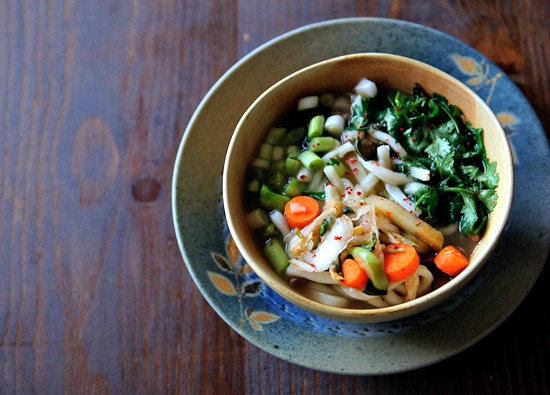
I recently taught a class on making lacto-fermented vegetables. We talked about sauerkraut, pickles, and kimchi, and I demo’ed how to make kimchi. I used a recipe just a wee bit different from this one…I’ve been making it over and over and I love it. One of the ways I like to eat it is mixed into this Asian-inspired Udon noodle soup.
This soup is ridiculously tasty; it’s also infinitely variable. Here’s how I make mine, along with some of my favorite ways to change it up.
How to Make Udon Noodle Soup

For 2 servings (or maybe 1: I’ve eaten the whole thing for dinner at once when I accidentally skipped lunch!), I start with 4 cups of chicken stock. I prefer to use homemade stock (here’s my chicken stock recipe; vegetable stock is another option, and so is store-bought stock).
Put the stock in a medium pot on the stove and add a few handfuls of kale leaves (torn away from the tough stems) plus the noodles. I like to use fresh udon noodles that come vacuum packed; but feel free to use whatever type of noodles floats your boat.
Once the stock is boiling, reduce to a simmer and cook until the noodles are tender. If you want to poach some fish or 1-2 eggs right in there, go ahead (or cook in a separate pan, if frying them).
At this point, take the soup off the heat and add whatever else you fancy for protein: cooked thinly sliced beef, or chicken, or maybe seafood (if you didn’t use the eggs/fish mentioned above).
Then garnish away (in the photo, you see generous amounts of chopped fresh cilantro, minced green onion, and lots of kimchi).
Udon Noodle Soup Variations
- Drop in two whole eggs (or use just the egg yolks) after you take the soup off the heat, or top with 1-2 fried eggs
- Add cubed silken tofu (or firm regular tofu sautéed in some coconut oil, rice vinegar, and tamari)
- Add thinly sliced beef or chicken (or try shrimp or scallops) that’s been stir-fried with minced garlic in some coconut or sesame oil, rice vinegar, and tamari; or add a fish filet (I like salmon) that’s raw (even frozen) and allow it to cook while the soup simmers
- Mix it up noodle-wise: use thin or wide rice noodles (gluten free), cellophane noodles (also gluten-free), soba (gluten-free if made from 100% buckwheat) or ramen-style noodles instead of the udon. If you avoid carbs (why, oh why?), then try this with vegetable noodles made in a spiral slicer
.
- Vary the greens: any and all will work; sometimes I add wakame seaweed, too
- Change up the broth by using vegetable or fish stock; try adding some miso after you take it off the heat; you can also stir in some coconut milk and/or add a few dashes of Asian fish sauce and a squeeze or two of fresh lime juice to boost the flavor. Drizzle with sriracha or a chili-garlic type sauce if you want it to be spicy.
- You could skip the kimchi, but that would be a silly thing to do!

More Asian-Inspired Soups
Vegetarian Pho
Coconut Salmon Soup
Coconut Curry Fish Soup
Udon Noodle Soup with Kale and Kimchi
Ingredients
- 4 cups chicken stock
- 2-3 handfuls fresh kale
- 14 ounces pre-cooked, vacuum-sealed udon noodles typically 2 7-oz packages or 1 14-oz package
- beef, chicken, tofu or other protein additions, as desired
- Garnish with cilantro, green onion, kimchi, etc., as desired







